Autophagy Study guides, Revision notes & Summaries
Looking for the best study guides, study notes and summaries about Autophagy? On this page you'll find 264 study documents about Autophagy.
Page 2 out of 264 results
Sort by
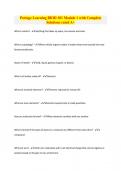
-
Portage Learning BIOD 101 Module 1 with Complete Solutions rated A+
- Exam (elaborations) • 14 pages • 2024
-
- £8.90
- + learn more
Portage Learning BIOD 101 Module 1 with Complete Solutions rated A+ What is matter? - Anything that takes up space, has volume and mass What is autophagy? - When cellular organic matter is broken down and recycled into new biomacromolecules States of matter - Solid, liquid, gaseous (vapor), or plasma What is all matter made of? - Elements What are essential elements? - Elements required for human life What are trace elements? - Elements required only in small quantities How are molecule...
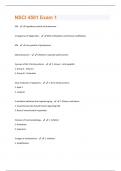
-
NSCI 4501 Exam 1 Questions Perfectly Answered
- Exam (elaborations) • 15 pages • 2024
- Available in package deal
-
- £6.20
- + learn more
19S - regulatory particle of proteasome 2 Categories of Epigenetics - DNA methylatioin and histone modification 20S - core particle of proteasome 26S proteasome - inhibited in sporadic parkinsonism 3 groups of Bcl-2 family proteins - 1. Group I - Anti-apoptitic 2. Group II - Inducers 3. Group III - Potentiate 3 key molecules of apoptosis - 1. Bcl-2 family proteins 2. Apaf-1 3. caspases 3 metabolic pathways that regulate aging - 1. Dietary restrictions 2. Insulin/Insulin-like Growth Fa...
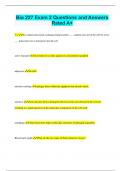
-
Bio 227 Exam 2 Questions and Answers Rated A+
- Exam (elaborations) • 11 pages • 2024
- Available in package deal
-
- £7.75
- + learn more
Bio 227 Exam 2 Questions and Answers Rated A+ 3, 2 the sodium potassium exchange pump transfers ___ sodium ions out of the cell for every ___ potassium ions it transports into the cell active transport movement of a solute against its concentration gradient adpocytes fat cells articular cartilage spongey bone within the epiphysis that absorbs shock autolysis when enzymes from a damaged cells lysosomes are released in the cytosol, resulting in a rapid digestion of the molecula...
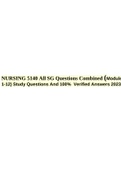
-
NURSING 5140 All SG Questions Combined (Module 1-12) Study Questions And 100% Verified Answers 2023.
- Exam (elaborations) • 608 pages • 2023
-
- £15.89
- 2x sold
- + learn more
NURSING 5140 All SG Questions Combined (Module 1-12) Study Questions And 100% Verified Answers 2023. Module 1 Study Questions Altered Cellular & Tissue Biology Ch. 2 1. Compare and contrast cellular injury and adaptation. 1. Compare and Contrast cellular injury and adaptation. Cellular Adaptation Cellular adaptation is an alteration that enables the cell to maintain a steady state called homeostasis despite adverse conditions. It is the cells response to protect itself from injur...

-
Biol 1201 Exam 1 (gregg) Questions With Verified Answers
- Exam (elaborations) • 11 pages • 2024
-
- £8.13
- + learn more
Biol 1201 Exam 1 (gregg) Questions With Verified Answers plasma membrane The membrane at the boundary of every cell that acts as a selective barrier, thereby regulating the cell's chemical composition. Ribosomes complexes that make proteins; free in cytosol or bound to rough ER or nuclear envelope Golgi apparatus active in synthesis, modification, sorting, and secretion of cell products Lysosome digestive organelle where macromolecules are hydrolyzed, and autophagy Mita...
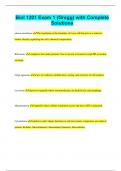
-
Biol 1201 Exam 1 (Gregg) with Complete Solutions
- Exam (elaborations) • 19 pages • 2024
- Available in package deal
-
- £7.75
- + learn more
Biol 1201 Exam 1 (Gregg) with Complete Solutions plasma membrane The membrane at the boundary of every cell that acts as a selective barrier, thereby regulating the cell's chemical composition. Ribosomes complexes that make proteins; free in cytosol or bound to rough ER or nuclear envelope Golgi apparatus active in synthesis, modification, sorting, and secretion of cell products Lysosome digestive organelle where macromolecules are hydrolyzed, and autophagy Mitachondrion org...
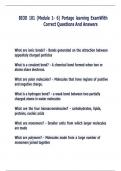
-
BIOD 101 (Module 1- 6) Portage learning Exam With Correct Questions And Answers
- Exam (elaborations) • 102 pages • 2024
- Available in package deal
-
- £31.78
- + learn more
BIOD 101 (Module 1- 6) Portage learning Exam With Correct Questions And Answers What are ionic bonds? - Bonds generated on the attraction between oppositely charged particles What is a covalent bond? - A chemical bond formed when two or atoms share electrons. What are polar molecules? - Molecules that have regions of positive and negative charge. What is a hydrogen bond? - a weak bond between two partially charged atoms in water molecules What are the four biomacromolecules? - carboh...

-
Portage Learning BIOD 101 Module 1 with Complete Solutions rated A+
- Exam (elaborations) • 14 pages • 2024
-
- £7.36
- + learn more
What is matter? - Anything that takes up space, has volume and mass What is autophagy? - When cellular organic matter is broken down and recycled into new biomacromolecules States of matter - Solid, liquid, gaseous (vapor), or plasma What is all matter made of? - Elements What are essential elements? - Elements required for human life What are trace elements? - Elements required only in small quantities How are molecules formed? - When elements combine with one another What is formed if ...
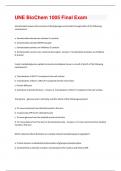
-
UNE BioChem 1005 Final Exam Questions and Answers Solved 100% Correct!!
- Exam (elaborations) • 14 pages • 2024
- Available in package deal
-
- £6.20
- + learn more
Somatostatin reduces the secretion of both glucagon and insulin through which of the following mechanisms? a. Somatostatin activates an activator G-protein b. Somatostatin activates MAPK cascade c. Somatostatin activates an inhibitory G-protein d. Somatostatin uses Ca+2 as a downstream signal - Answer c. Somatostatin activates an inhibitory G-protein Insulin mediated glucose uptake by muscle and adipose tissue is a result of which of the following mechanisms? a. Translocation of GLUT 4 ...
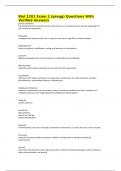
-
Biol 1201 Exam 1 (gregg) Questions With Verified Answers
- Exam (elaborations) • 11 pages • 2024
-
- £8.91
- + learn more
Biol 1201 Exam 1 (gregg) Questions With Verified Answers plasma membrane The membrane at the boundary of every cell that acts as a selective barrier, thereby regulating the cell's chemical composition. Ribosomes complexes that make proteins; free in cytosol or bound to rough ER or nuclear envelope Golgi apparatus active in synthesis, modification, sorting, and secretion of cell products Lysosome digestive organelle where macromolecules are hydrolyzed, and autophagy Mita...

£5.50 for your revision notes multiplied by 100 fellow students... Do the math: that's a lot of money! Don't be a thief of your own wallet and start uploading yours now. Discover all about earning on Stuvia


